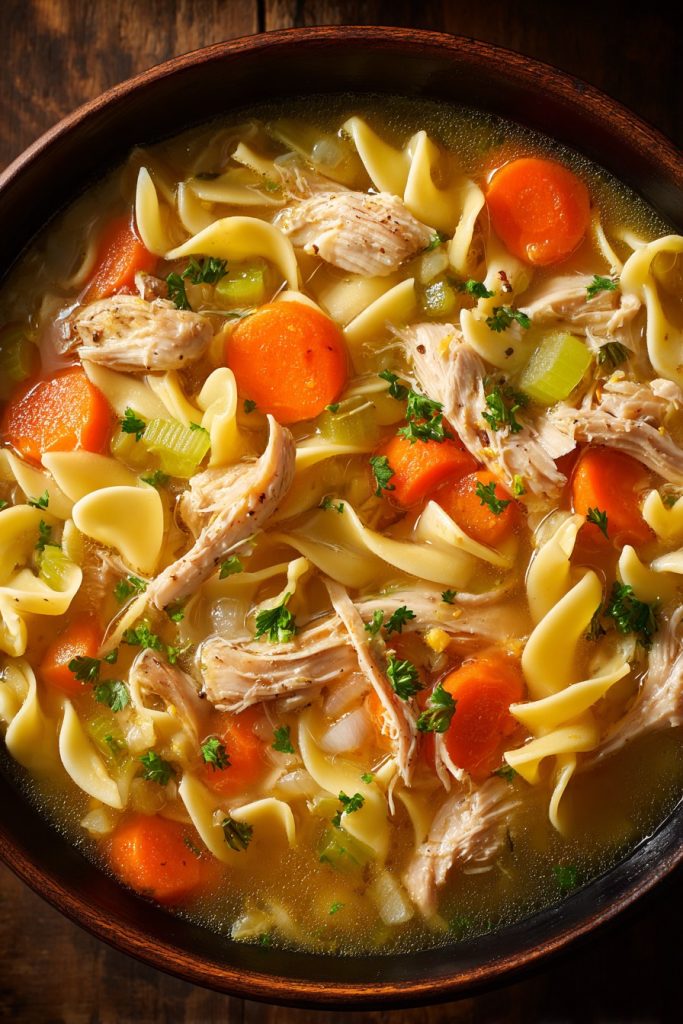Ready to dive into the coziest bowl of comfort? This bone-in chicken noodle soup isn’t just your average weeknight dinner—it’s a hug in a bowl that’ll warm you from the inside out. Rich, flavorful, and packed with wholesome goodness, it’s the perfect remedy for chilly days or when you need a little extra TLC.
Why This Recipe Works
- Using bone-in chicken thighs instead of boneless adds incredible depth of flavor and richness to the broth, thanks to the collagen and marrow that slowly release during cooking.
- Simmering the soup low and slow allows the flavors to meld together perfectly, creating a complex, hearty base that’s far superior to quick versions.
- Adding the egg noodles towards the end ensures they maintain the ideal al dente texture without becoming mushy or overcooked.
- Finishing with a splash of fresh lemon juice and herbs brightens up the entire dish, balancing the richness with a touch of acidity and freshness.
Ingredients
- 2 pounds bone-in, skin-on chicken thighs
- 1 tablespoon olive oil
- 1 large yellow onion, finely diced
- 3 carrots, peeled and sliced into 1/4-inch rounds
- 3 celery stalks, finely chopped
- 4 cloves garlic, minced
- 8 cups chicken broth (low sodium preferred)
- 2 bay leaves
- 1 teaspoon dried thyme
- 1/2 teaspoon black pepper
- 8 ounces wide egg noodles
- 1/4 cup fresh parsley, chopped
- 2 tablespoons fresh lemon juice
- Salt to taste
Equipment Needed
- Large Dutch oven or heavy-bottomed pot
- Cutting board and chef’s knife
- Measuring cups and spoons
- Tongs
- Ladle
- Soup bowls for serving
Instructions

Step 1: Brown the Chicken to Perfection
Heat the olive oil in your large Dutch oven over medium-high heat until it shimmers, about 2-3 minutes. Pat the chicken thighs completely dry with paper towels—this is crucial for achieving that beautiful golden-brown sear instead of steaming. Season both sides generously with salt and pepper, then carefully place them skin-side down in the hot oil. Cook without moving for 6-8 minutes until the skin is deeply golden brown and crispy. Flip and cook for another 4-5 minutes until the other side is nicely browned. Remove the chicken to a plate, leaving the rendered fat in the pot. This initial browning step creates incredible fond (those browned bits at the bottom) that will flavor your entire soup.
Step 2: Sauté the Aromatics Until Fragrant
Reduce the heat to medium and add the diced onion, carrots, and celery to the same pot. Cook, stirring occasionally, for 8-10 minutes until the vegetables have softened and the onions become translucent. You’ll notice the edges of the vegetables starting to caramelize slightly, which adds wonderful depth. Add the minced garlic and cook for just 1 minute more until fragrant—be careful not to burn it as burned garlic turns bitter. Use your wooden spoon to scrape up all those delicious browned bits from the chicken from the bottom of the pot; this is where so much flavor lives! The vegetables should be tender but still have some texture at this stage.
Step 3: Simmer the Broth to Develop Deep Flavor
Return the browned chicken thighs to the pot along with any accumulated juices. Pour in the chicken broth, making sure to scrape the bottom thoroughly to incorporate all the flavorful bits. Add the bay leaves, dried thyme, and additional black pepper. Bring the mixture to a boil over high heat, then immediately reduce to a gentle simmer. Partially cover the pot and let it simmer for 45-60 minutes, until the chicken is fall-apart tender and the broth has developed a rich, golden color. The low, slow cooking allows the collagen from the bones to dissolve into the broth, creating that luxurious mouthfeel that makes this soup so special.
Step 4: Shred the Chicken and Return to Pot
Using tongs, carefully remove the chicken thighs from the broth and place them on a cutting board to cool slightly, about 5-10 minutes until manageable. Discard the skin and bones—they’ve done their job flavoring the broth! Use two forks to shred the chicken meat into bite-sized pieces, discarding any excess fat or gristle. Return all the shredded chicken to the pot, stirring to distribute evenly. Taste the broth and season with additional salt if needed—remember the noodles will absorb some saltiness later. The soup should already taste deeply flavorful at this stage, with the chicken tender and the vegetables soft but not mushy.
Step 5: Cook the Noodles to Al Dente Perfection
Increase the heat to medium-high and bring the soup back to a steady simmer. Add the egg noodles and cook according to package directions, usually 8-10 minutes, stirring occasionally to prevent sticking. Test the noodles at the minimum time—they should be tender but still have a slight bite (al dente). Remember they’ll continue to soften slightly in the hot broth even after cooking. Once the noodles are perfectly cooked, immediately remove the pot from the heat to prevent overcooking. Fish out and discard the bay leaves—they’ve released their flavor and can be bitter if left in.
Step 6: Finish with Fresh Herbs and Brightness
Stir in the chopped fresh parsley and lemon juice right before serving. The parsley adds a pop of color and fresh flavor, while the lemon juice brightens the entire soup and cuts through the richness. Let the soup stand for 2-3 minutes to allow the flavors to meld. Ladle into warm bowls, making sure each serving gets plenty of chicken, vegetables, and noodles. Serve immediately while hot, with extra lemon wedges on the side for those who want an extra zing. The finished soup should have a beautiful balance of rich broth, tender chicken, and perfectly cooked noodles.
Tips and Tricks
For the absolute best flavor, consider making your own chicken broth from scratch using the bones after shredding the chicken. Simply return the bones to the pot with additional water, onion, carrot, and celery scraps, and simmer for 2-3 hours. Strain and use this ultra-rich broth in place of store-bought—the difference is incredible! If you’re short on time, you can use a rotisserie chicken instead of raw thighs. Remove the meat from the bones, then simmer the bones in store-bought broth for at least 30 minutes to extract maximum flavor before proceeding with the recipe. For a clearer broth, you can skim off any foam or excess fat that rises to the surface during simmering. Use a wide, shallow spoon and skim periodically for the first 15 minutes of cooking. If you prefer a thicker soup, you can make a quick slurry by mixing 2 tablespoons of cornstarch with 1/4 cup cold water, then stirring it into the simmering soup during the last 5 minutes of cooking. To make this soup ahead, prepare everything except the noodles. Store the broth with chicken and vegetables in the refrigerator for up to 3 days, then reheat and add fresh noodles when ready to serve. This prevents the noodles from becoming soggy. For freezing, omit the noodles entirely as they don’t freeze well. Freeze the broth with chicken and vegetables for up to 3 months, then add freshly cooked noodles when reheating. If your soup seems too greasy, you can easily remove excess fat by chilling it until the fat solidifies on top, then skimming it off before reheating. For extra depth, add a Parmesan rind to the broth while simmering—it adds incredible umami flavor. Always taste and adjust seasoning after adding the noodles, as they tend to absorb salt. If you accidentally oversalt, add a peeled, raw potato to the soup while simmering—it will absorb some of the saltiness.
Recipe Variations
- For a creamy version, stir in 1/2 cup of heavy cream or full-fat coconut milk during the last 5 minutes of cooking. This creates a luxurious, velvety texture that’s perfect for extra cold days. You can also add a tablespoon of butter for added richness.
- Make it spicy by adding 1-2 teaspoons of red pepper flakes when sautéing the vegetables, or stir in a tablespoon of sriracha or chili garlic sauce at the end. Garnish with sliced jalapeños for an extra kick.
- Transform it into chicken and dumplings by omitting the noodles and instead dropping spoonfuls of biscuit dough onto the simmering soup. Cover and cook for 15-20 minutes until the dumplings are cooked through.
- Create a Greek-inspired version by adding 1 teaspoon of dried oregano with the thyme, and stirring in 2 cups of fresh spinach during the last 5 minutes. Finish with a sprinkle of feta cheese and fresh dill.
- For an Asian twist, use rice noodles instead of egg noodles, add 1 tablespoon of grated fresh ginger with the garlic, and substitute soy sauce for salt. Garnish with sliced green onions and a drizzle of sesame oil.
Frequently Asked Questions
Can I use boneless chicken instead of bone-in?
While you certainly can use boneless chicken, the bone-in version creates a significantly richer, more flavorful broth. The bones release collagen and marrow during cooking, which gives the soup that luxurious, silky texture and deep chicken flavor that’s hard to achieve with boneless cuts. If you do use boneless, consider adding a few chicken wings or feet to the broth while simmering to compensate for the missing bones, then remove them before serving.
How do I prevent the noodles from getting mushy?
The key to perfect noodles is adding them towards the very end and cooking them just until al dente. They’ll continue to soften in the hot broth even after you turn off the heat, so it’s better to slightly undercook them. If you’re making the soup ahead, cook the noodles separately and add them to each bowl when serving. Store leftover soup with noodles separately from the broth if possible.
Can I make this soup in a slow cooker?
Absolutely! Brown the chicken and sauté the vegetables as directed, then transfer everything to your slow cooker along with the broth and seasonings. Cook on low for 6-8 hours or high for 3-4 hours. Remove the chicken to shred, then return it to the pot and add the noodles. Cook on high for another 20-30 minutes until noodles are tender. Finish with fresh herbs and lemon juice.
How long does leftover soup keep in the refrigerator?
The soup will keep well in an airtight container in the refrigerator for 3-4 days. The noodles will continue to absorb liquid and become softer, so you may need to add a bit of extra broth when reheating. For best quality, consider storing the broth and noodles separately if you know you’ll have leftovers. Reheat gently on the stove over medium heat, stirring occasionally.
Can I use different types of noodles?
You can absolutely customize the noodles to your preference! Egg noodles are classic, but feel free to use wide pasta like pappardelle, or even gluten-free options like brown rice noodles. Just adjust the cooking time according to the package directions. Smaller pasta like orzo works well too—just note that it will thicken the soup more than larger noodles. Always taste-test as you go since cooking times vary.
Summary
This bone-in chicken noodle soup delivers incredible flavor through careful browning, slow simmering, and fresh finishes. The rich broth, tender chicken, and perfect noodles create the ultimate comfort food experience that’s worth every minute of cooking time.



